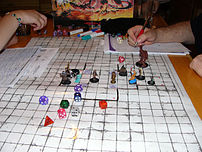
 Image via Wikipedia
Image via Wikipedia
A guest post by Daniel Donahoo
Children are born to role play.
It is one of the key ways in which children learn. Ok, so it isn’t all dice, paper and miniatures, but children have been creating their own RPGs forever. They don’t even use dice.
All the early childhood development professionals know this only too well. Children mimic and recreate the worlds – pre-school teachers set up pretend shops, pirate ships or moonscapes encouraging the creation of both real and make-believe worlds. In these worlds children adopt characters and create personalities in which they can test out behaviors and interactions. (sound familiar)
We know roleplaying is fun, educational and entertaining. So, how can we further foster this roleplaying in our children so it thrives beyond preschool?
My own boys (aged 5 & 6) got me thinking about this when every second Friday they ask the same question: “Are you playing Dungeons & Dragons here tonight?”
Now, the fact we are now using GURPS is a technicality. But, a fellow role-playing dad and I have been exploring what role-playing games might engage children who are just starting school to continue their learning through role-playing (and learn a bit more about how Dungeons and Dragons works). These explorations exposed us to a whole world where geeks in classrooms have used role-playing to support learning history and science, where role-players had developed a range of different gaming systems as an introduction to RPGs for children.
I’ve heard details of a dad running Call of Cthulhu games for his teenage daughter and her friends over at Yog-Sothoth through to running my own ‘rpg experiments’ with my own children. What follows are some suggestions about how to engage children of different ages in role-playing.
In my limited experience children are far more capable role-players than many adults. They immerse themselves in a scenario and character fully. While the “roll-playing” for younger children needs to be moderated, the “role-playing” can provide exceptional moments.
The Early Years (4 – 7 years)
Is four-years-old too young to play an RPG? Not if you have a couple of older children (say 6 or 7) play with. Of course, if you want children to abide by all the rules exactly and have a detailed knowledge of movement and encumbrance rates and initiative then you are setting yourself and the kids up for failure and a pretty uninspiring time.
The focus at this age should be on the “role-playing”, rather than “roll-playing”.
You need a game that will take anywhere from 20 – 60 min. It should have a clear and simple narrative. Young children really grasp the idea of a linear story and strong characters.
So, rescuing someone or something, or climbing to the top of a mountain. These things make sense and are interesting goals for young children (as long as you throw a few encounters along the way).
This age group also responds well to using miniatures. They find it easier to role-play characters they can see. Though, they can do it with paper and pencils around a table, but they prefer to have a representation of their character.
For this reason, sometimes it is good to get them to draw their character. Also, no matter what the game as them to choose three words to describe their character and explain they have to act like their character. Sometimes you get words like “red”, but to see a child role-play “red” can be a very comical experience.
Like I said, be flexible around the rules. That said, it is amazing how quickly children this age picked up on the idea that rolling the dice was crucial to an outcome. So they’d say, “I attack him, where are the dice?” without drawing breath. Only in the beginning will they need to be reminded to roll. They pick it up quickly. Now, surely developing an appreciation for the dice is a fine achievement and a valuable lesson for any future role-players.
Keys to RPGing with 4 – 7 year-olds
• The story – Focus on a clear linear narrative
• The characters – Great to have miniatures, or pictures of characters
•
The Rules – Keep them simple, don’t worry about them too much. But, introduce the concept of rolling the dice helps to produce an outcome
(either positive or negative)
Recommended Games
Fuzzy Heroes
This has become our staple RPG
at home. We modify the rules a little and the children have to turn their soft toys into heroes of fuzz to battle the naughty renegade boy toys. It is more like miniatures war-gaming really, but you can introduce narratives with clear goals.
It keeps mums happy because characters don’t die, they “fall asleep”. And, I allow the kids to create their own “super power” –whatever they want – it adds to the creativity.
Purchase at – http://www.fuzzyheroes.com/catalog.php
Shadows
This clever little game allows children to play themselves and their “shadow”. It is a great introduction for telling a story and having “events” happen. It can go as long or as short as you like, and is a good sit down and tell a story table-top rpg. Author,
Zak Arntson, has created a few good free RPGs for children. All worth checking out.
Free download at – http://www.harlekin-maus.com/games/shadows/shadows.html
Faery’s Tale
I haven’t actually played this game. But, it has been highly recommended by others. It may be a little more complex for younger children, but the interactive story telling elements sound great. Might be a great one to play if you are also reading the kids
Enid Blyton’s Faraway Tree series or similar stuff.
Purchase at – http://www.firefly-games.com/index.php
School Agers (8 – 12 years)
The value of this age group is that the rules can become more complex and developed, especially around character engagement. Players can develop characters that do interact with each other. They will pick up quickly on the “My player hates your player because…” type line. Go with this type of play, as long as it doesn’t become a focus or spill over into real life.
You can begin to play games with more sophisticated rules, particularly around engagement and battles. But, may wish to hold off the finer details that may add to realism, but will bore this age group; I’m thinking encumbrance, detailed hit locations and the like.
This age also have a better sense of “the grand narrative”. So, try and set up a series of adventures in the same game world, or have a series of chapters. Keep the pace of the game up, but use open-ended questions to help the players thinking about what their characters will do and allow them to help tell the story. (i.e. The forest is dark and gloomy, you hear whispers from the trees, how does your character feel?) By getting players to describe how their characters feel, you can then ask them what they will do – based on how they feel. This helsp set the mood and guide good roleplaying.
Keys to RPGing with 8 – 12 year-olds
• The story – Focus on building a sustained narrative across a few sessions.
•
The characters – Encourage character development. Get players to focus on their characters bad or good habits, how they feel and react.
•
The Rules – Focus on introducing more sophisticated rules as players seem ready. This age will focus on making sure the rules are stuck to by all players. But, they will feel disempowered if the rules are too difficult. (and go and find a computer game instead).
Recommended Games
RPG Jr
Those interested in preparing their kids for the Forgotten Realms and some traditional D&D style roleplaying – whatever the edition – RGG Jr is probably a good place to start. There are two types of characters: fighters and wizards. The gameworld is all castles, forests, magic and swords.
Read more at http://gamingbasics.com/rpgjr/index.html
Broomstix (a Harry Potter RPG)
This might be a good one to introduce to any Harry Potter fans. By leveraging off the interest in the book, you may just foster a future roleplayer of the highest order.
I mean, how many people found MERP or D&D through Tolkein?
Download pdf at http://www.memento-mori.com/other/games/broomstix_rpg.pdf
Teenagers (13 – 99 years)
As kids head into their teens, everyone can start getting serious. Especially if you’ve been working them up it by now they should be ready for some classic D&D, a simple Call of
Cthulhu setting (maybe limit the human sacrificing though) or any setting really if you want to apply it to GURPS. Imagine learning about
Ancient Egypt for history by playing a slave working on some pyramid.
Or immersing yourself as a viking setting in Cthulhu Dark Ages.
At this stage, your young ‘uns might be asking you to get out of the way and to quit it with those “I attack the darkeness” jokes because they are just not cool.
But, if you’ve done the ground work they should be erecting shrines to Gary Gygax, modifying their miniatures and not letting anyone use their lucky d20.
Keys to RPGing with 13+ year-olds
• The story – Focus on interests and fun. Remember it is a game. That is the best lesson to teach. Not to take it too seriously.
•
The characters – Get sophisticated. Ask for research and written character backgrounds, introduce miniatures start learning the art of painting, whatever takes the players fancy.
• The Rules – You can expand the range of your games, by playing RPGs with more complex rules and systems that deliver a host of more realistic and challenging aspects to your and your children’s gaming.
Recommended Games
Take your pick…Dungeons and Dragons, Teenage Mutant Ninja Turtles, Marvel Super Heroes, Call of Cthulhu…you know the list.
An excellent list of games and links can be found at – http://www.tlucretius.net/RPGs/kids.html
GeekDad would like to thank Daniel for his post!
![Reblog this post [with Zemanta]](http://img.zemanta.com/reblog_e.png?x-id=37d105ad-aed6-4230-9b15-9508c6220aeb)


